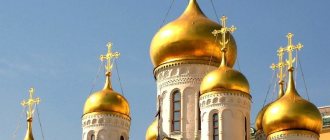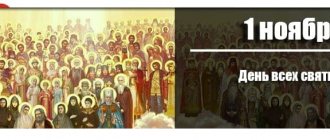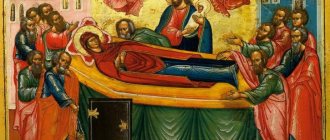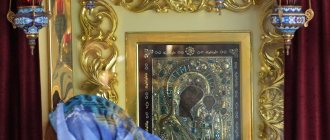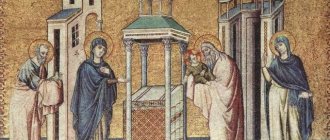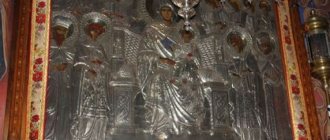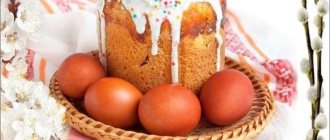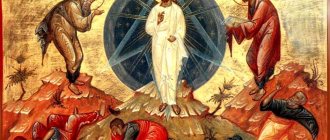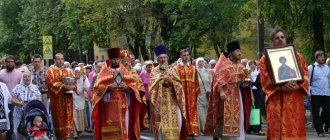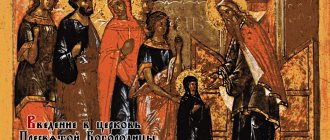What is the Dormition of the Virgin Mary
The Dormition of the Mother of God reveals to us one of the miracles performed by the Lord after His Ascension into heaven. We know about the life of the Mother of God after this event only from the apocrypha (ancient religious texts not included in the canon of Holy Scripture). And also according to legends dating back to the 1st - 8th centuries. The Dormition is the blessed death of the Most Holy Theotokos.
Dormition of the Blessed Virgin Mary (Orthodox icon)
Dormition: celebration traditions
The Dormition is solemnly celebrated by all faiths, celebrations take place in Jerusalem and in all countries where there are Christian communities. In Gethsemane, where according to legend the tomb of the Mother of God is located, the rite of burial of the Virgin Mary is held. According to Orthodox tradition, the Assumption service continues throughout the night.
In Rus', the Assumption was one of the most important and beloved folk holidays dedicated to the harvest. The holiday was popularly called the First Most Pure Day . (Second Most Pure - Nativity of the Theotokos, September 21; Third Most Pure - Entry of the Mother of God into the Temple, December 4).
The peasants specifically left one unharvested sheaf on the field before the Dormition, which was called the pre-harvest sheaf. On the holiday, the sheaf was solemnly cut and various rituals were performed with it, which were supposed to ensure the safety of the current year's harvest and protect against hunger and crop failure next year.
With the Assumption, the young Indian summer began (until September 11), in addition, on this holiday all “woman’s sins” were forgiven.
The sign read:
“If the weather is good for the young Indian summer, expect bad weather for the old one (that is, since September 11).”
It was not customary to work for the Assumption; hard work, washing, cooking and handicrafts were generally prohibited, but it was possible to start pickling cucumbers.
Also at this time, winter crops began to be sown. There was a saying:
“The First Most Pure One sows the crops; the Second Most Pure One helps her.”
Federal News Agency /
At this time, according to tradition, the time for autumn weddings began, which were mainly held on Intercession (October 14).
Also, on the Assumption, it was customary to consecrate the grain of the new harvest and bread baked from it in churches.
On this day in Rus', bread alms were generously given to the poor and prisoners in prisons. Refusal from works of mercy was strictly condemned; it was believed that a heartless person brings disaster not only to himself, but also to his loved ones and even neighbors.
According to tradition, on this day girls were forbidden to cut their hair and braid their hair, otherwise, according to superstition, they would not get married.
It was forbidden to walk barefoot on the Assumption; it was believed that the earth was watered with bitter tears in connection with the death of the Mother of God and these tears made everything around poisonous.
It was strictly forbidden to quarrel, argue, create scandals, and especially to use foul language; the Mother of God could become angry and send dumbness or even madness.
Holiday events
When the days of the earthly life of the Mother of God came to an end, she returned from the places (Athos, Cyprus, Ephesus) where she preached the Gospel message to Jerusalem. The Mother of God had many enemies and envious people. They sought, if not to kill, then to imprison her, but God protected Her. She spent days and nights in prayer. She often went to the Holy Sepulcher, lit lamps there and prayed. The haters of the Mother of God decided to prevent Her from doing this. The High Priest placed guards around the Tomb. But the Mother of God still came there - the Lord hid Her from the eyes of the soldiers.
One day, while praying to the Mother of God, the Archangel Gabriel appeared and announced Her imminent death. Hearing this, the Mother of God began to pray to the Son that He would allow her to say goodbye to the apostles. And the Lord transferred his disciples, who dispersed across the earth in different directions preaching, to the house of the Most Holy Theotokos. Only Thomas was not with the apostles that day.
For three hours the apostles said goodbye to the Virgin Mary, and finally She bestowed her blessing on them. After this time, the candles in the room suddenly dimmed and a divine radiance spread around the Mother of God. The Lord descended from heaven with angels and some Old Testament prophets, took the soul of the Mother of God and took Her to heaven.
The solemn funeral procession to the burial place outraged the enemies of Jesus and His Most Pure Mother. They wanted to kill the apostles and destroy the body of the Mother of God, but the Lord separated the procession with an invisible wall. The angry residents of the city and their servants heard the singing. However, neither the disciples of Christ nor the bed of the Mother of God were seen. So the procession reached Gethsemane, where the Most Pure Mother of God was buried.
Three days later, the Apostle Thomas arrived in Jerusalem. He was very sad that he did not have time to say goodbye to the Mother of God, so he decided to venerate Her holy body. But, approaching the tomb, the apostle saw that it was empty. The body of the Virgin Mary disappeared, leaving only fragrant clothes in the tomb.
What needs to be done on this day
A joyful event is celebrated by visiting church and attending a solemn service.
Before the service begins, you must light a candle and pray to bless all relatives and loved ones.
This is a very important day when the Mother of God hears prayers for children in a special way. When visiting church, you should ask:
- health for kids;
- a good share for unmarried children;
- so that they do not depart from the faith;
- for help to overcome worldly temptations.
Advice!
When leaving the church, it is customary to give alms to those in need, begging not only near the temple, but also to those living nearby. Everyone should enjoy this holiday, especially those who are financially vulnerable. The memorable day of the heavenly departure of the Mother of God gives a happy family life to those couples who marry during the holiday.
Housewives are not prohibited from making preparations, especially pickling cucumbers, tomatoes, and collecting vegetables left in the garden.
This time is favorable for forest hikes to pick mushrooms, viburnum, and also harvest pears and apples.
History and meaning of the holiday
Like other feasts of the Mother of God, the Dormition of the Blessed Virgin Mary entered church life only in the region of the 7th - 9th centuries. It is curious that even the memory of the martyrs began to be celebrated earlier. This was probably due to the fact that they died in front of other Christians. While the Mother of God remained an inaccessible quantity. The emergence and spread of the Mother of God holidays was facilitated by the Nestorian heresy (which arose in the 5th century), which defamed the memory of the Mother of God. In order to protect the good name of the Mother of God and give her due respect, Christians decided to especially celebrate events related to Her life.
Initially, the Nativity of the Mother of God and the Feast of the Assumption of the Blessed Virgin Mary were celebrated on the same day. But closer to the 8th century, the dates of the celebrations were divided. The exact date of the holiday changed frequently. In the 7th century, holidays were celebrated in the Coptic Church on January 16, in the Armenian Church on August 15. The Roman Church celebrated the Dormition on January 18, and the Ascension of the Virgin Mary’s soul into heaven on August 14. In the 8th century, the holiday was fixed on August 15. And the Byzantine emperor Mauritius made it common to the church in gratitude for his victory over the Persians.
Now we celebrate the Dormition on August 28 according to the new style (15 according to the old style). Just like the Jerusalem, Georgian, Serbian and some other Orthodox Churches. The Old Believers adhere to the same tradition. The Catholic Church celebrates August 15th.
About the rite of burial of the Mother of God
Shroud of the Blessed Virgin Mary
This tradition came to us from Western Russian lands and became widespread in the 16th century. In some Orthodox churches, the rite is served especially solemnly until the celebration of the Dormition itself, that is, on the 14th.
A shroud with the image of the Virgin Mary is brought to the middle of the church, and then it is solemnly carried around the temple. The observance is imitative of the Matins of Holy Saturday. Today, in practice in parishes, the rite of burial is performed on the eve of the Dormition, as well as on one of the next days of the post-feast.
Interesting fact
In the 19th century in the Gethsemane monastery of the Holy Trinity Sergius Lavra with the blessing of St. Philaret On August 17, according to the old style, the Resurrection and Ascension of the Ever-Virgin Mary was celebrated.
The meaning of the Dormition of the Blessed Virgin Mary
Christmas and the Dormition of the Mother of God are two holidays, one of which opens and the other closes the church calendar. This location was not chosen by chance. After all, it is the Mother of God who is the beginning and the end of the Gospel story, in the center of which is Jesus Christ.
Having left this world, the Mother of God appeared to the grieving apostles and uttered the following phrase: “Rejoice! I am with you all the days." We should all remember Her words, She will not leave us in trouble. This is the uniqueness of her Assumption. The Lord, having taken the soul of the Mother of God, ascended Her body to heaven, again uniting them together. Theologians designate the Dormition only as the sleep of the Mother of God, which ended when the Savior ascended her to heaven. Because of this, people call the feast of the Dormition of the Mother of God “Little Easter” (summer Easter).
Prayers
Troparion, tone 1
At Christmas you preserved your virginity, / in the Dormition you did not abandon the world, O Mother of God, / you reposed to the belly, / Mother of the Being of the Belly, / and through your prayers you delivered our souls from death.
Kontakion, tone 2
In prayers, the never-sleeping Mother of God / and in intercessions, the immutable hope / the grave and mortification cannot be restrained: / as if the Mother of the Life / was placed in the life / in the womb of the ever-virgin one.
Greatness
We magnify Thee, / Immaculate Mother of Christ our God, / and glorify the all-glorious / Thy Dormition.
Features of worship and celebration
The holiday is preceded by a two-week Assumption Fast, which in severity is second only to Lent. In addition to the usual bans, a ban on fish and vegetable oil is added. The Assumption Fast is the only fast dedicated to the Mother of God. It symbolizes the grief of family members before the death of the mother. The Dormition of the Most Holy Theotokos is celebrated by the entire Church as one family, so preparations for the event are appropriate.
At the evening celebration, the same proverbs (passages from Old Testament texts related to the holiday) are read as at the Nativity of the Blessed Virgin Mary. The lithium is served and the consecration of the loaves takes place. At key places of the service, the troparion and kontakion of the holiday are sung, and two holiday canons are also read. At the Liturgy, the troparion and kontakion of the holiday are sung, as well as the tribute to the Assumption: “The rules of nature are conquered.”
The peculiarity of both the holiday and strict fasting is that they are based not on the Gospel tradition, but on much later evidence. And the basis for the beginning of their celebration was the reverence that Christians felt before the Virgin Mary. This happened with virtually no interference in traditions on the part of church hierarchs. The Mother of God was always revered, and the feast of Her blessed Dormition was widespread and celebrated until the 8th century. But at the same time he was not recognized by the entirety of the Universal Church.
Dormition post
As a serious preparation for the worthy meeting of the Dormition, the Orthodox have prescribed fasting abstinence for fourteen days. The Assumption Fast lasts from August 14 to August 27.
This is one of the most important “long” posts. Despite the fact that it is addressed to everyone, its observance to one degree or another must be in accordance with the blessing of a personal confessor who knows well the condition of each of his children.
What can you eat?
According to the ancient charter:
- on Monday, Wednesday and Friday the eating of fish dishes, oil and wine is not allowed; dry eating is blessed only after Vespers;
- the remaining days of the week are free to eat food with vegetable oil.
Fish is allowed on Saturdays and Sundays, as well as on Transfiguration on August 19. This assumption is possible on the dates of patronal celebrations and the memory of saints, unless they fall on Wednesday or Friday.
Interesting fact
During the Dormition Fast, as well as on the feast of the Dormition of the Virgin Mary itself, it is not customary to celebrate a wedding. But you can be baptized; the sacrament of Baptism is performed on any day.
At that time, smokers have a good opportunity to get rid of the addiction or at least reduce the number of cigarettes they consume.
The same applies to any addiction: watching entertainment programs on TV, going to the theater, and other hobbies that can obscure the main thing from us - preparing our inner man for a meeting with God, bringing our life to at least some compliance with the commandments set out in the Gospel.
A model of meekness and purity, the Holy Virgin sets an example of righteousness, and with it the strength to overcome any spiritual adversity.
Prohibited actions
There are some things you should be careful with on an important church holiday. With what exactly is listed below.
- It is prohibited to engage in any “menial” work: around the house or in the garden;
- you cannot quarrel, get involved in conflicts, showdowns;
- You can’t do handicrafts or cut your hair;
- It’s worth throwing any bad thoughts out of your head on such a bright day;
- It is unacceptable to cook food. In connection with this ban, Christian believers prepare holiday dishes in advance. After all, as the belief goes, if you cook food on Dormition Day, you will soon experience need;
- It is forbidden to use piercing or cutting objects: even the bread for the Assumption is not cut off, but broken off by hand;
- Another fairly common prohibition associated with this holiday is that it is unacceptable to walk barefoot on the ground so as not to attract various ailments;
- do not wear old, worn-out shoes on the feast of the Virgin Mary - otherwise, later in life you will be accompanied by various problems and difficulties;
- and an unmarried girl should not utter a word on the morning of the Assumption. First, she should wash herself three times in icy water, saying the following speech:
“Most Holy Mother of God, you have crowned everyone, united families, help me find a groom. In the name of the Father, Son and Holy Spirit. Amen".
Iconography
A typical Byzantine icon depicting the Dormition of the Mother of God has the following composition. In its lower part the body of the deceased Mary is depicted, surrounded by sad apostles. The deathbed is draped in precious purple cloth. On the floor is a stand decorated with gold and precious stones. Western artists even depicted the crown and scepter.
Of course, all these attributes do not fit in with the daily life of the Mother of God, who was very modest in everyday life. But this is how the icon painters wanted to emphasize the status of the future Queen of Heaven.
The Apostle John stands closest to the other apostles, because it was to him that Christ bequeathed the care of His Mother. The Apostle Peter is depicted with a censer. In the saint's omophorions one can see Dionysius the Areopagite and Jacob, the earthly brother of the Lord. It is also customary to depict theologians on icons of the Assumption who wrote about this event, but were not physically present at it.
Contrasting with earthly sorrow from above is Christ holding in his hands the soul of his Mother, depicted in the form of a child - a symbol of the birth of the soul of the Virgin Mary into eternal life. This is exactly how She held the Divine Child in Her arms. On both sides of Him are jubilant angels.
Other icons depicted the apostles in the clouds, which, according to legend, were transferred to Jerusalem to bid farewell to Mary. Sometimes the Old Testament prophets who wrote about the Mother of God in prototypes are depicted, or Authonius (with his hands cut off) - a Jew who tried to interfere with the funeral procession on the streets of Jerusalem. The upper part of the icons often depicts the ascension of the Mother of God and her subsequent coronation. Open heavenly gates can also be seen on icons.
On the day of the holiday, Assumption icons are usually placed in the festive row of the iconostasis. In Assumption churches, icons are located to the right of the icon of the Savior.
Signs associated with the Assumption
People have always noticed various changes in nature on this or that holiday and tried to predict the weather based on them. What will the weather conditions tell us on the day of the Dormition of the Virgin Mary?
- clear weather on August 28 means a cool Indian summer is expected;
- spiders have made a lot of webs - you need to prepare to experience a frosty winter, but there will be little snow;
- if a rainbow appears in the sky, autumn promises to be warm;
- and one more sign not related to the weather - if an unmarried girl did not manage to find a groom before Assumption Day, it means that within the next year she will also be alone.
Finally, also watch a video about this Christian holiday:
Memory
The Tomb of Our Lady is located in Gethsemane, at the foot of the Mount of Olives, in Jerusalem. According to some information, the first basilica to appear on this site was built by order of the Holy Equal-to-the-Apostles Queen Helena. In 614 the temple was destroyed, but the tomb remained. The main owner of the building is the Jerusalem Greek-Orthodox Patriarchate. The Armenian Apostolic Church also has rights to it. Other Christian denominations have the right to perform services.
Every year before the Feast of the Assumption, a religious procession from the chapel near the Church of the Holy Sepulcher is sent here. It is in this chapel that the Shroud of the Blessed Virgin Mary is kept. The Orthodox procession follows the path of the apostles who carried the body of the Mother of God to burial.
The Shroud is a double-sided carved image of the Blessed Virgin lying on her deathbed. It is kept here throughout the year until the Orthodox holiday of the Dormition of the Virgin Mary.
The shroud is carried by the abbot on a wide silk sling over his shoulder with a velvet pillow. The procession arrives at the tomb of the Mother of God at sunrise. The Shroud rests on the sacred bed on which the body of the Most Pure Mother of God rested, and remains on it until the day of the feast.
By decision of the VI Ecumenical Council in 641, the tomb of the Mother of God was opened. Nothing was found in it except a belt and burial shrouds.
